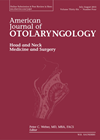
Journal Reviews
Painful temporomandibular joints
This paper is a meta-analysis of randomised controlled trials comparing arthrocentesis with conservative management in painful and restricted mouth opening temporomandibular joint symptoms. Temporomandibular joint dysfunction comprises a spectrum of disorders commonly involving facial pain and loss of oral function...
How does temporomandibular dysfunction affect voice-related quality of life?
Temporomandibular dysfunction (TMD) is a group of neuromuscular or musculoskeletal problems that affect the muscles and fascia related to chewing and jaw opening. Patients are often seen in ENT clinics because of symptoms such as trismus, pain and muscle tension,...
Parapharyngeal space tumours – is the transoral approach effective?
Several approaches are described to the parapharyngeal space to permit resection of tumours in this region, with the most commonly employed approach being the transcervical route. The transoral approach remains somewhat controversial as it is felt that this approach can...
Piezoelectric saw reducing sensory disturbance in mandibular osteotomies
This paper from Seattle in the United States looked at 20 patients with a mean age of 19.9 +/- 3.2 years with a fairly standard surgical movement. They found that functional sensory recovery of the inferior alveolar nerve resulted in...
TMJ arthrocentesis
This is a paper from Brazil where they attempted to clarify the volume required for an arthrocentesis to the temporomandibular joint. Nineteen cadavers had methylene blue injected into the upper joint space. Conventional arthrocentesis was then conducted with 300ml of...
Surgical management of refractory osteoradionecrosis
This is a French single-centre, 10-year experience of 55 surgical resection and reconstruction procedures. They claim an overall effectiveness rate of 92.3%. A total of 36 segmental and 19 marginal mandibulectomies were performed. A variety of free flaps were used,...
Locked or unlocked?
This systematic review and meta-analysis from the Netherlands evaluates postoperative complications of mandibular fractures using locking and non-locking systems. It is suggested that postoperative complications of surgical treatment of mandibular fractures occur in 20-26% of patients, and it is thought...
Infection in prosthetic temporomandibular joints
This is an overview from an internationally recognised TMJ surgeon. It is a comprehensive article highlighting the incidence is likely to be underestimated and prevention the main objective. Eradication is very difficult. Not surprisingly, a lot of the conclusions are...
Long-term quality outcomes of bimaxillary surgery of obstructive sleep apnoea
This is a review of 12 patients at two years postoperatively and again at at least 17 years. Successful outcome of a decrease in apnoea-hypopnoea index (AHI) of greater than 50% was thought to be success. Eight of the initial...
Maxillomandibular advancement for sleep apnoea
This is a meta-analysis compiled from India. Of the initial 103 publications, 20 were analysed. Surgical cure was defined as postsurgical AHI of fewer than five events per hour. Of the 251 patients assessed for AHI, 12 were considered normal,...
We should all use ultrasound-guided core needle biopsy when investigating salivary gland lesions
Ultrasound core needle biopsy of salivary glands is an excellent diagnostic tool in terms of accuracy (both sensitivity and specificity), technical performance, and safety profile. This paper provided an update of the previous meta-analysis of the same question, which found...
Obstructive sleep apnoea: Does maxillomandibular advancement work?
This is a paper from the Netherlands reviewing 62 patients who underwent maxillomandibular advancement for moderate to severe obstructive sleep apnoea. The authors observed a 71% success rate with mean apnoea hypopnea index (AHI) reduction of 69%. There was no...














